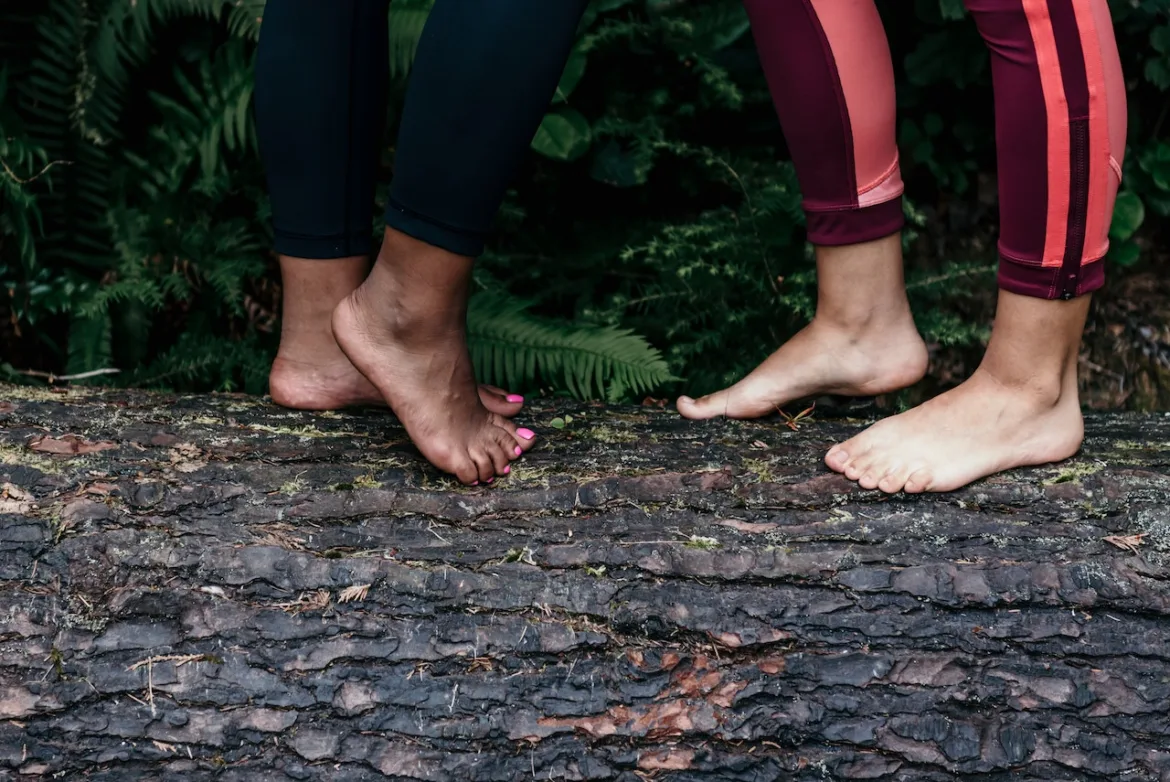Introduction
In our fast-paced, modern world, we often find ourselves disconnected from nature, spending most of our days indoors and wearing insulated shoes that separate us from the Earth’s natural energy.
Grounding barefoot, also known as earthing, is a practice that seeks to remedy this disconnection by allowing direct contact between our bodies and the Earth.
This article explores the benefits of grounding barefoot, how long it takes to feel a difference, and how to know if it’s working.

Table of Contents
The Concept of Grounding Barefoot
Grounding barefoot involves making physical contact with the Earth’s surface. This can be achieved by walking, standing, or sitting on natural surfaces like soil, sand, grass, or even rock without the barrier of shoes or synthetic materials. The Earth carries a negative electrical charge, and proponents of grounding believe that this connection helps to balance and restore the body’s electrical state.

Benefits of Grounding Barefoot
Stress Reduction: Grounding is believed to reduce stress by helping the body regulate the stress hormone cortisol. It promotes a sense of calm and relaxation.
Improved Sleep: Many people report improved sleep quality after grounding. It is thought to regulate circadian rhythms and reduce insomnia.

Pain Relief: Grounding has been associated with reduced pain and inflammation, particularly for individuals with chronic pain conditions.
Enhanced Immunity: Some proponents argue that grounding can enhance the immune system’s functioning, although scientific research on this aspect is still ongoing.
Better Circulation: Grounding may improve blood flow and circulation, leading to better oxygenation of cells and tissues.
Reduced Inflammation: Grounding may help reduce chronic inflammation, which is linked to various diseases and conditions.
Increased Energy: People who practice grounding often report increased vitality and energy levels.
How to Ground:
Grounding is a straightforward practice that can be incorporated into your daily routine. Here’s a basic guide on how to ground:
Find a Natural Surface: Seek out a natural surface like grass, soil, sand, or rock. It should be free of synthetic materials like concrete or asphalt.
Remove Footwear: Take off your shoes and socks, allowing your bare feet to make direct contact with the Earth.
Connect Mindfully: Stand, walk, sit, or lie down on the natural surface. Spend at least 20-30 minutes or more if possible.
Breathe and Relax: While grounding, take deep, mindful breaths, and relax your body. You can meditate, read, or simply enjoy the serenity of nature.
Be Consistent: For optimal benefits, aim to ground regularly, ideally daily. You can ground in your backyard, at the beach, or in a nearby park.
Remember that the practice of grounding is individual, and the key is to connect with nature while staying present in the moment. Over time, you may experience the numerous benefits that grounding has to offer.

How Long Does It Take to Feel a Difference?
The time it takes to feel a noticeable difference from grounding barefoot can vary from person to person. Some individuals might experience benefits immediately, while others may take a few weeks or even months of regular grounding. Several factors can influence the time frame, including:

Duration and Consistency: The longer and more consistently you practice grounding, the quicker you may experience results. Daily exposure is ideal.
Individual Sensitivity: Some individuals are more sensitive to the effects of grounding and may notice changes sooner.
Health Status: If you have chronic health issues, it may take longer to see significant improvements, but grounding can still be beneficial.
Environmental Factors: The location and type of surface you ground on can also affect how quickly you experience benefits.
How to Know Grounding Is Working
Recognising the effectiveness of grounding can be somewhat subjective, as it depends on your individual experiences and goals. Nevertheless, there are a few common signs to look out for:
Improved Sleep: If you find that your sleep quality is improving and you wake up feeling more refreshed, grounding may be having a positive effect.
Reduced Pain or Inflammation: If you suffer from chronic pain or inflammation, any reduction in symptoms may be indicative of the grounding’s benefits.
Increased Relaxation: Feeling more relaxed, less stressed, and mentally clear is a sign that grounding is working to balance your body’s energy.
Enhanced Well-being: Overall improvements in your physical and emotional well-being are positive indicators that grounding is effective for you.
Personal Feedback: Pay attention to how you feel after grounding sessions. If you consistently experience a sense of peace, vitality, or connectedness to the Earth, it is likely working for you.

Conclusion
Grounding barefoot is a simple, natural practice that allows us to reconnect with the Earth’s electrical energy. While scientific research on grounding is still evolving, many people report positive effects on their well-being.
To experience the benefits of grounding, aim for regular and consistent practice, and be patient, as it can take varying amounts of time to see and feel noticeable changes.
Ultimately, how well grounding works for you is a personal journey, and the best way to determine its effectiveness is through self-awareness and attentive observation of your own body and mind.

FAQs
What is grounding, and how does it work?
Grounding, also known as earthing, is the practice of making direct physical contact with the Earth’s surface, such as walking or sitting on natural materials like soil, grass, or sand without the barrier of shoes. The Earth carries a negative electrical charge, and grounding is believed to help balance and restore the body’s electrical state. This practice aims to facilitate the flow of electrons between the Earth and the body, potentially promoting physical and emotional well-being.
What are the potential health benefits of grounding?
The potential benefits of grounding include stress reduction, improved sleep, pain relief, enhanced immunity, better circulation, reduced inflammation, and increased energy. Many people report feeling more relaxed, experiencing less pain, and enjoying better sleep after incorporating grounding into their routines. While some of these claims are supported by anecdotal evidence, scientific research on grounding is still ongoing.
How long does it take to feel the effects of grounding?
The time it takes to notice the effects of grounding can vary from person to person. Some individuals may experience benefits immediately, while others might require several weeks or even months of regular grounding. Factors such as the duration and consistency of grounding, individual sensitivity, health status, and environmental factors can all influence the timeline of experiencing benefits.
Is there scientific evidence supporting the benefits of grounding?
While there is some scientific research on grounding, it is an area that is still being explored. Some studies have shown positive effects of grounding on sleep, stress, and inflammation, but more rigorous research is needed to establish concrete scientific evidence for all of the claimed benefits. It’s essential to view grounding as a complementary practice and consult with healthcare professionals when addressing specific health concerns.
Can I ground indoors, or does it have to be outdoors?
Grounding is most commonly practised outdoors, with direct contact with the Earth’s natural surface. However, it is possible to ground indoors using grounding mats, sheets, or earthing products that are connected to a grounding outlet or a metal rod placed in the Earth. While indoor grounding methods can provide some of the benefits, they may not offer the same experience as being directly connected to the Earth’s surface.



